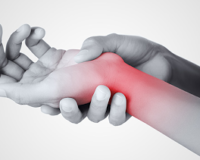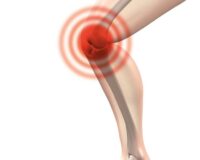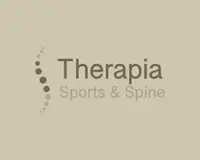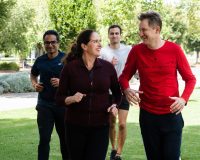That’s How I Roll (A guide to using the foam roller for knee pain)
I’d like to introduce you to the foam roller, which is usually a blue cylinder, and can be your best friend when it comes to improving knee pain.
A foam roller can be used to stretch muscles that are difficult to stretch otherwise, provide self-treatment massage, and assist in making exercises more difficult (or more targeted). While there has been a lot more awareness about foam rollers lately, I find that most people have one sitting away in the cupboard (or shed) & aren’t too sure what to do with it. I’m hoping this advice will help!
There are so many different areas of the body that a foam roller can help with. However, today we are going to discuss the knee.
Knee Pain & the Foam Roller
There are many different issues that can cause knee pain. Arthritis (or worn-out cartilage), ligament/meniscal injury or surgery, and patella maltracking issues are problems that we commonly see. The good news is that all of these problems will respond well to being rolled!
While there are many different ways in which knee problems will affect the surrounding tissues, there are some areas that consistently get weak and tight and can go on to cause further pain and problems.
In regards to weakness, the main important muscles that can get weakened with, or lead to, knee pain are the VMO (or Vastus Medialis Oblique, an inner part of the Quadriceps at the front of the thigh) and the Gluteus Medius (the middle supporting layer of the gluteal muscles in the buttock).
The main muscle responsible for contributing to much knee pain when it gets tight is the Iliotibial Band (ITB), which is a band-like muscle running down the outside of the thigh. It forms its attachment from the Gluteus Maximus at the back and the Tensor Fascia Latae at the front of the hip, and runs down to attach at the outer knee.
Why are these muscles so important?
The VMO is the main muscle that supports the kneecap, and therefore knee, and ensures that it moves in the femoral grooves of the knee that it is supposed to. Unfortunately, it seems to weaken whenever there is knee pain, such as with Arthritis, injury and post-surgery. Without the VMO working properly, the kneecap can be pulled out of the femoral grooves, usually towards the outer knee. In this case, the repeated incorrect movement of the kneecap can lead to increased weakness of the VMO (& in turn, more pain), and increased tightness of the outer thigh muscle, the ITB (Ilio-tibial band), leading to ongoing issues and pain. You could think of the VMO and the ITB as being involved in a tug-of-war with the kneecap – when they work together, the kneecap moves correctly. However, when the VMO is weakened and the ITB becomes tight, the ITB “wins” and can pull the kneecap out of its grooves.
The Gluteus Medius is the main supporting muscle of the hip, and in turn, the entire lower limb. As well as assisting in moving the hip joint, this muscle works to support the lower limb in single leg stance (eg. Walking). If the Gluteus Medius is not functioning properly, the hip joint will not be supported properly and may rotate inwards. This will cause the lower limb to rotate inwards, and lead to more pressure on the inside of the knee (where the pressure is placed). This can directly cause knee pain and dysfunction, and also, due to the change in muscle pull, this will mean that the ITB will be tightened indirectly.
What happens when the ITB becomes tight – is it really such a big problem?
The ITB is a particularly nasty muscle when it becomes tight, as it can cause and progress many problems. When it is tight, because it spans such a large distance, the ITB can cause knee pain and also outer hip pain. The ITB is very difficult & awkward to stretch, and without correction it may continue to get tighter and cause more problems.
This is why it is great to use the roller this muscle as soon as you notice any pain.
What can I do on the foam roller for knee pain?
The main muscles that respond well to the foam roller for knee pain are the ITB, Quads and Glutes.
1) Rolling the ITB
Start on your side, with your ITB resting on the roller, and lift yourself up with your arm.
Place the other leg in front.
Basically, you want to roll over the muscle (not the bones), and so don’t go over the outside of the hip or knee – just stick to the “meaty” area in between.
Slowly roll your thigh up and down over the roller.
If there is a particularly tender point, you can keep pressure over that area or even gently roll around that area.
Aim for 1-2 minutes on each side per day.
2) Rolling the Quadriceps
Start with both of your thighs over the roller, and rest onto your elbows/arms.
Aim to roll from above the kneecap up to a comfortable level of the thigh.
Slowly roll forwards and backwards over the roller.
Aim for 1-2 minutes per day.
3) Rolling the Gluteals
Start with sitting on the roller, slightly leaning towards the side you are targeting.
Rest your hand(s) behind you on the floor.
Slowly roll forwards and backwards.
Aim for 1-2 minutes each side per day.
A gentle word of warning: if your muscles are particularly tight, and if you have not used a foam roller previously (especially for the ITB), rolling them may feel rather uncomfortable. Unfortunately, this is normal and you will need to push past a certain level of discomfort to see improvements. Rest assured this will be something that eases as your muscle tightness improves.
Can I use a foam roller to strengthen the muscles too?
In addition to using the foam roller for massage and stretching exercises, it can also be used to help strengthen weakened muscles. As discussed earlier, the gluteals (especially gluteus medius) play a big part in lower limb stability, including knee stability. Here are a few great exercises that you can do with the roller for these muscles:
Bridging with the Foam Roller
Place feet onto the foam roller
Slowly lift buttocks off floor, followed by one vertebra at a time
Slowly roll back down
Try 15 repetitions
Straight-leg bridging with Foam Roller
With legs straight, place calf muscles onto foam roller
Slowly lift buttocks off floor
Once lifted, you can try to lift one leg straight up – hold 5 seconds
Try 10 repetitions
“Doggie lift” (with foam roller)
Start on all 4’s with hands on roller (hands under shoulder level)
Keep knee bent to 90 degrees and slowly lift leg out to the side.
Squeeze buttocks together as you lift – slowly return. (Back should stay still)
Try 10 repetitions each side
(If you are interested to read more about Gluteal exercises to improve strength, please see our previous blog, “Toning the Thighs, Gluteals and Pelvic Floor”).
Happy exercising & getting to know your roller! If you have any questions about the above information/exercises, or would like to know more, please ask your physiotherapist at Therapia. Please feel free to call us on 8221 5011, or email us at info@therapia.com.au if you have any questions or queries.
Book Appointment




